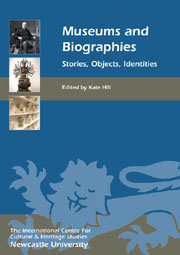Book contents
- Frontmatter
- Contents
- List of Illustrations
- Introduction: Museums and Biographies – Telling Stories about People, Things and Relationships
- INDIVIDUAL BIOGRAPHY AND MUSEUM HISTORY
- PROBLEMATISING INDIVIDUALS' BIOGRAPHIES
- INSTITUTIONAL BIOGRAPHIES
- OBJECT BIOGRAPHIES
- MUSEUMS AS BIOGRAPHY
- 16 Houses and Things: Literary House Museums as Collective Biography
- 17 ‘Keepers of the Flame’: Biography, Science and Personality in the Museum
- 18 National History as Biography: Alexandre Lenoir's Museum of French Monuments
- MUSEUMS AS AUTOBIOGRAPHY
- Endpiece: The Homunculus and the Pantograph, or Narcissus at the Met
- List of Contributors
- Index
16 - Houses and Things: Literary House Museums as Collective Biography
from MUSEUMS AS BIOGRAPHY
Published online by Cambridge University Press: 05 February 2013
- Frontmatter
- Contents
- List of Illustrations
- Introduction: Museums and Biographies – Telling Stories about People, Things and Relationships
- INDIVIDUAL BIOGRAPHY AND MUSEUM HISTORY
- PROBLEMATISING INDIVIDUALS' BIOGRAPHIES
- INSTITUTIONAL BIOGRAPHIES
- OBJECT BIOGRAPHIES
- MUSEUMS AS BIOGRAPHY
- 16 Houses and Things: Literary House Museums as Collective Biography
- 17 ‘Keepers of the Flame’: Biography, Science and Personality in the Museum
- 18 National History as Biography: Alexandre Lenoir's Museum of French Monuments
- MUSEUMS AS AUTOBIOGRAPHY
- Endpiece: The Homunculus and the Pantograph, or Narcissus at the Met
- List of Contributors
- Index
Summary
In 1979, not long after David Parker became curator of the Charles Dickens Museum in London, he addressed one of the first conferences on literary museums, reflecting on the designs and effects of an exhibit in a writer's former home (Barthel and Kunze 1986, 4). He expressed envy of Thomas Carlyle's House, a museum that inherited many original possessions and documentation of the arrangement of the rooms along with a large body of biography about Thomas and Jane Carlyle: ‘The rest of us should be so lucky!’ (Parker 1986, 2). The museum's trust, first private and then national, had been able to reconstruct the former residence of the Carlyles. Some even more fortunate collections had never been dislodged: houses like ‘Kipling's Batemans …, Shaw's Corner …, and even Disraeli's Hughenden Manor … in which the principal rooms, at least, survive … intact, as they were the day the author died’. In such as-lived-in museums, the challenge for the curator is ‘conservation’ rather than reconstruction of rooms, with possible ‘annexes’ for exhibiting ‘showcase’ objects (Parker 1986, 25). Yet some museums begin with little else than a house associated with the figure who once lived there. Whether and how to recreate a typical period setting or to reproduce the rooms at one phase in the life of the house; to exhibit an archive or to mount thematic displays – the decisions must be made in any house museum.
- Type
- Chapter
- Information
- Museums and BiographiesStories, Objects, Identities, pp. 231 - 246Publisher: Boydell & BrewerPrint publication year: 2012

